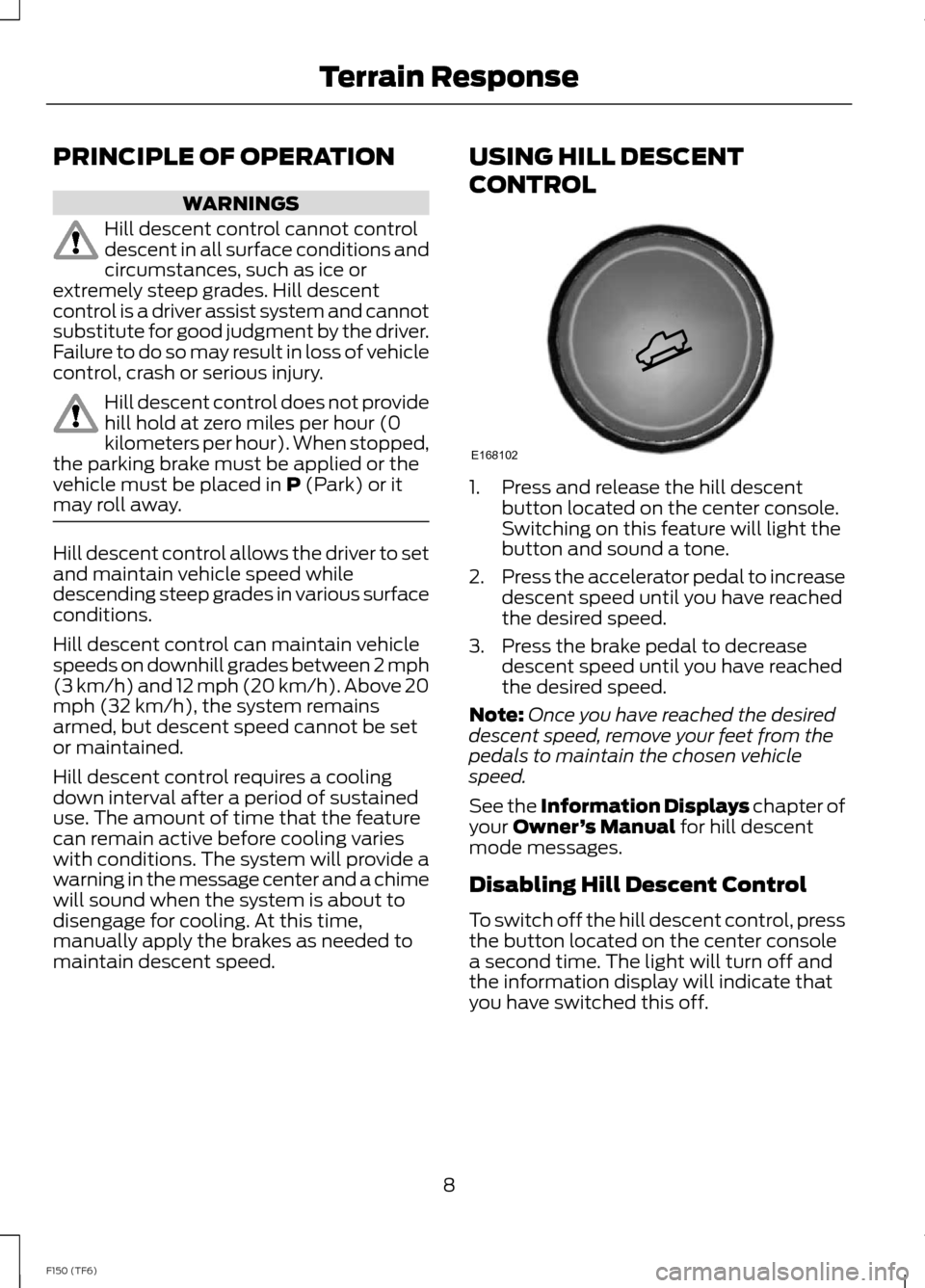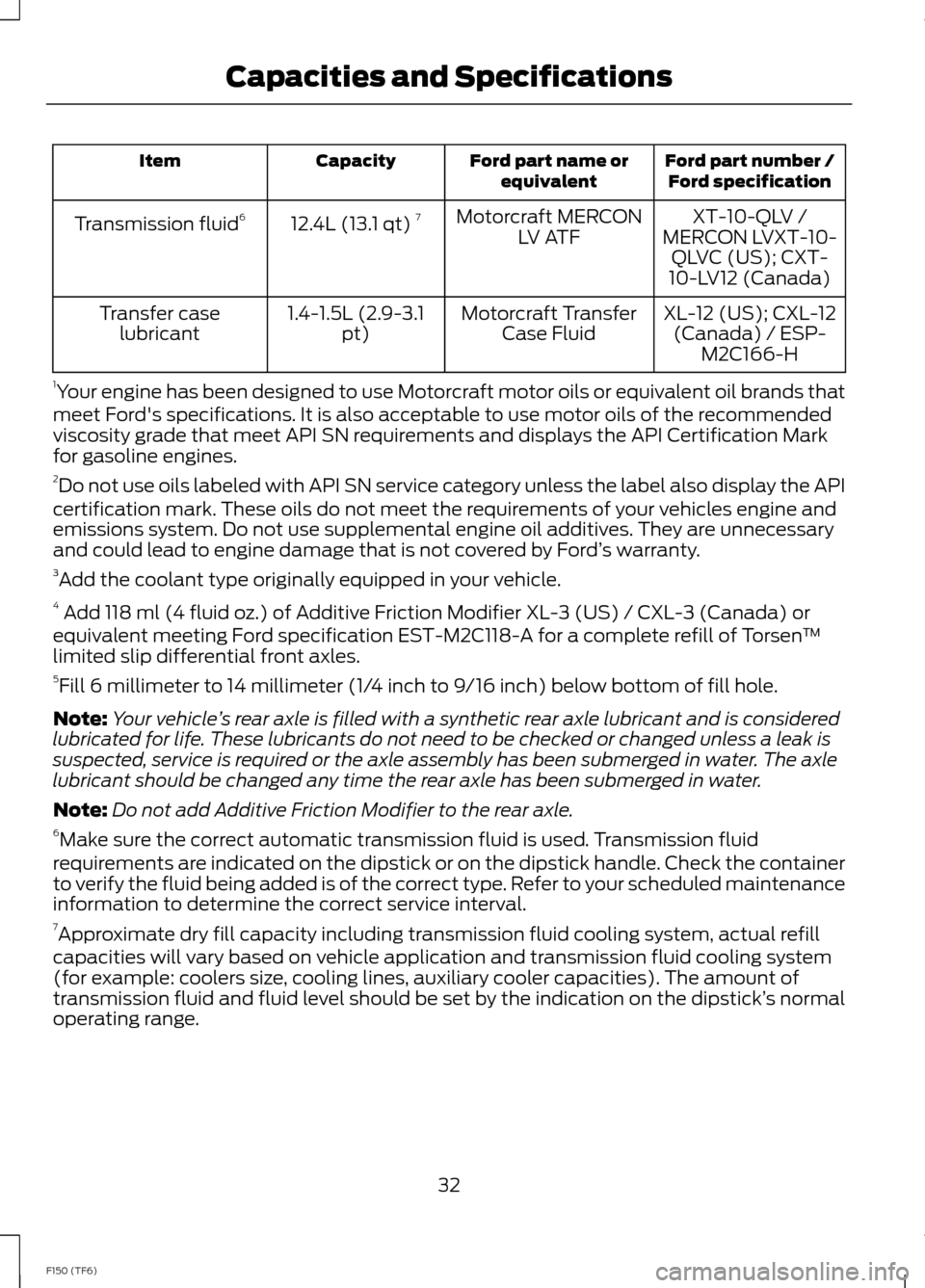Page 10 of 41

PRINCIPLE OF OPERATION
WARNINGS
Hill descent control cannot controldescent in all surface conditions andcircumstances, such as ice orextremely steep grades. Hill descentcontrol is a driver assist system and cannotsubstitute for good judgment by the driver.Failure to do so may result in loss of vehiclecontrol, crash or serious injury.
Hill descent control does not providehill hold at zero miles per hour (0kilometers per hour). When stopped,the parking brake must be applied or thevehicle must be placed in P (Park) or itmay roll away.
Hill descent control allows the driver to setand maintain vehicle speed whiledescending steep grades in various surfaceconditions.
Hill descent control can maintain vehiclespeeds on downhill grades between 2 mph(3 km/h) and 12 mph (20 km/h). Above 20mph (32 km/h), the system remainsarmed, but descent speed cannot be setor maintained.
Hill descent control requires a coolingdown interval after a period of sustaineduse. The amount of time that the featurecan remain active before cooling varieswith conditions. The system will provide awarning in the message center and a chimewill sound when the system is about todisengage for cooling. At this time,manually apply the brakes as needed tomaintain descent speed.
USING HILL DESCENT
CONTROL
1.Press and release the hill descentbutton located on the center console.Switching on this feature will light thebutton and sound a tone.
2.Press the accelerator pedal to increasedescent speed until you have reachedthe desired speed.
3.Press the brake pedal to decreasedescent speed until you have reachedthe desired speed.
Note:Once you have reached the desireddescent speed, remove your feet from thepedals to maintain the chosen vehiclespeed.
See the Information Displays chapter ofyour Owner’s Manual for hill descentmode messages.
Disabling Hill Descent Control
To switch off the hill descent control, pressthe button located on the center consolea second time. The light will turn off andthe information display will indicate thatyou have switched this off.
8F150 (TF6)Terrain ResponseE168102
Page 26 of 41

•
•It is highly encouraged that you switchto off-road mode and perform anAdvanceTrac single press to make sureimproved off-road brakingperformance under these conditions.Be sure to disengage the off-roadmode and switch back to AdvanceTrackey-on mode before performing anystreet driving. Please see the Off-RoadMode section of this supplement formore details.
After Off-Road Driving
It is important to complete a full vehicleinspection after off-road driving. Someitems to check include:
•Make sure that tires are inflated toproper tire pressure as indicated on thetire placard.
•Check the wheels and undercarriagefor built up mud or debris which cancause vehicle vibration.
•Make sure that the grille and radiatorare clear of any obstructions that mayaffect cooling.
•Make sure that the brakes are in properworking order and free of any mud,stones and debris, which can becometrapped around the brake rotor,backing plate and caliper.
•Check that the air filter is clean and dry.
•Inspect for torn or punctured boots onball joints, half shafts, steering gears.
•Inspect exhaust system for damage orlooseness.
•Inspect undercarriage fasteners. If anyare loose or damaged, tighten orreplace ensuring that the proper torquespecification is used.
•Inspect the tires for any cuts in thetread or sidewall area. Also inspect thesidewall for any bulge indicatingdamage to the tire.
•Inspect the wheels for dents, cracks,or other damage.
24F150 (TF6)Driving Hints
Page 34 of 41

Ford part number /Ford specificationFord part name orequivalentCapacityItem
XT-10-QLV /MERCON LVXT-10-QLVC (US); CXT-10-LV12 (Canada)
Motorcraft MERCONLV ATF12.4L (13.1 qt) 7Transmission fluid6
XL-12 (US); CXL-12(Canada) / ESP-M2C166-H
Motorcraft TransferCase Fluid1.4-1.5L (2.9-3.1pt)Transfer caselubricant
1Your engine has been designed to use Motorcraft motor oils or equivalent oil brands thatmeet Ford's specifications. It is also acceptable to use motor oils of the recommendedviscosity grade that meet API SN requirements and displays the API Certification Markfor gasoline engines.2Do not use oils labeled with API SN service category unless the label also display the APIcertification mark. These oils do not meet the requirements of your vehicles engine andemissions system. Do not use supplemental engine oil additives. They are unnecessaryand could lead to engine damage that is not covered by Ford’s warranty.3Add the coolant type originally equipped in your vehicle.4 Add 118 ml (4 fluid oz.) of Additive Friction Modifier XL-3 (US) / CXL-3 (Canada) orequivalent meeting Ford specification EST-M2C118-A for a complete refill of Torsen™limited slip differential front axles.5Fill 6 millimeter to 14 millimeter (1/4 inch to 9/16 inch) below bottom of fill hole.
Note:Your vehicle’s rear axle is filled with a synthetic rear axle lubricant and is consideredlubricated for life. These lubricants do not need to be checked or changed unless a leak issuspected, service is required or the axle assembly has been submerged in water. The axlelubricant should be changed any time the rear axle has been submerged in water.
Note:Do not add Additive Friction Modifier to the rear axle.6Make sure the correct automatic transmission fluid is used. Transmission fluidrequirements are indicated on the dipstick or on the dipstick handle. Check the containerto verify the fluid being added is of the correct type. Refer to your scheduled maintenanceinformation to determine the correct service interval.7Approximate dry fill capacity including transmission fluid cooling system, actual refillcapacities will vary based on vehicle application and transmission fluid cooling system(for example: coolers size, cooling lines, auxiliary cooler capacities). The amount oftransmission fluid and fluid level should be set by the indication on the dipstick’s normaloperating range.
32F150 (TF6)Capacities and Specifications